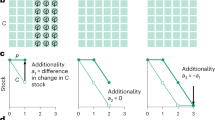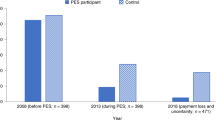Abstract
Payments for Environmental Services (PES) constitute an innovative economic intervention to counteract the global loss of biodiversity and ecosystem functions. In theory, some appealing features should enable PES to perform well in achieving conservation and welfare goals. In practice, outcomes depend on the interplay between context, design and implementation. Inspecting a new global dataset, we find that some PES design principles pre-identified in the social-science literature as desirable, such as spatial targeting and payment differentiation, are only partially being applied in practice. More importantly, the PES-defining principle of conditionality—monitoring compliance and sanctioning detected non-compliance—is seldom being implemented. Administrative ease, multiple non-environmental side objectives and social equity concerns may jointly help explain the reluctance to adopt more sophisticated, theoretically informed practices. However, by taking simplifying shortcuts in design and implementation, PES programmes may become less environmentally effective and efficient as economic incentives, thus underperforming their conservation potential.
This is a preview of subscription content, access via your institution
Access options
Access Nature and 54 other Nature Portfolio journals
Get Nature+, our best-value online-access subscription
$29.99 / 30 days
cancel any time
Subscribe to this journal
Receive 12 digital issues and online access to articles
$119.00 per year
only $9.92 per issue
Buy this article
- Purchase on Springer Link
- Instant access to full article PDF
Prices may be subject to local taxes which are calculated during checkout


Similar content being viewed by others
References
Pearce, D. W. & Barbier, E. Blueprint for a Sustainable Economy (Earthscan, London, 2000).
Ferraro, P. J. & Kiss, A. Direct payments to conserve biodiversity. Science 298, 1718 (2002).
Wunder, S. Revisiting the concept of Payments for Environmental Services. Ecol. Econ. 117, 234–243 (2015).
Wunder, S., Engel, S. & Pagiola, S. Taking stock: a comparative analysis of Payments for Environmental Services programs in developed and developing countries. Ecol. Econ. 65, 834–852 (2008).
Brouwer, R., Tesfaye, A. & Pauw, P. Meta-analysis of institutional-economic factors explaining the environmental performance of payments for watershed services. Environ. Conserv. 38, 380–392 (2011).
Bulte, E. et al. Payments for ecosystem services and poverty reduction: concepts, issues, and empirical perspectives. Environ. Dev. Econ. 13, 245–254 (2008).
Samii, C., Lisiecki, M., Kulkarni, P., Paler, L. & Chavis, L. Effects of Payment for Environmental Services (PES) on Deforestation and Poverty in Low and Middle Income Countries: A Systematic Review CEE 13-015b (Collaboration for Environmental Evidence, 2014).
Börner, J. et al. Emerging evidence on the effectiveness of tropical forest conservation. PLoS ONE 11, e0159152 (2016).
Engel, S. The devil in the detail: a practical guide on designing Payments for Environmental Services. Int. Rev. Environ. Resour. Econ. 9, 179–207 (2016).
Wunder, S. When Payments for Environmental Services will work for conservation. Conserv. Lett. 6, 230–237 (2013).
Pascual, U. et al. Social equity matters in payments for ecosystem services. BioScience 64, 1027–1036 (2014).
Muradian, R. et al. Payments for ecosystem services and the fatal attraction of win–win solutions. Conserv. Lett. 6, 274–279 (2013).
Kinzig, A. P. et al. Paying for ecosystem services—promise and peril. Science 334, 603–604 (2011).
Naeem, S. et al. Get the science right when paying for nature’s services. Science 347, 1206–1207 (2015).
Pagiola, S., Honey-Rosés, J. & Freire-González, J. Evaluation of the permanence of land use change induced by Payments for Environmental Services in Quindío, Colombia. PLoS ONE 11, e0147829 (2016).
Engel, S. & Muller, A. Payments for Environmental Services to promote “climate-smart agriculture”? Potential and challenges. Agric. Econ. 47, 173–184 (2016).
Polasky, S., Lewis, D. J., Plantinga, A. J. & Nelson, E. Implementing the optimal provision of ecosystem services. Proc. Natl Acad. Sci. USA 111, 6248–6253 (2014).
Ferraro, P. Asymmetric information and contract design for payments for environmental services. Ecol. Econ. 65, 810–821 (2008).
Miteva, D., Pattanayak, S. & Ferraro, P. Evaluation of biodiversity policy instruments: what works and what doesn’t? Oxf. Rev. Econ. Policy 28, 69–92 (2012).
Pattanayak, S. K., Wunder, S. & Ferraro, P. J. Show me the money: Do payments supply environmental services in developing countries? Rev. Environ. Econ. Policy 4, 254–274 (2010).
Börner, J. et al. The effectiveness of Payments for Environmental Services. World Dev. 96, 359–374 (2017).
Sattler, C., Trampnau, S., Schomers, S., Meyer, C. & Matzdorf, B. Multi-classification of payments for ecosystem services: How do classification characteristics relate to overall PES success? Ecosyst. Serv. 6, 31–45 (2013).
Hejnowicz, A. P., Raffaelli, D. G., Rudd, M. A. & White, P. C. L. Evaluating the outcomes of payments for ecosystem services programmes using a capital asset framework. Ecosyst. Serv. 9, 83–97 (2014).
Ezzine-de-Blas, D. et al. Global patterns in the implementation of Payments for Environmental Services. PLoS ONE 11, e0149847 (2016).
Jack, B. K., Kousky, C. & Sims, K. R. E. Designing payments for ecosystem services: lessons from previous experience with incentive-based mechanisms. Proc. Natl Acad. Sci. USA 105, 9465–9470 (2008).
Locatelli, B., Imbach, P. & Wunder, S. Synergies and trade-offs between ecosystem services in Costa Rica. Environ. Conserv. 41, 27–36 (2014).
Wünscher, T., Engel, S. & Wunder, S. Spatial targeting of Payments for Environmental Services: a tool for boosting conservation benefits. Ecol. Econ. 65, 822–833 (2008).
Alix-Garcia, J., De Janvry, A. & Sadoulet, E. The role of deforestation risk and calibrated compensation in designing Payments for Environmental Services. Environ. Dev. Econ. 13, 375–394 (2008).
Muñoz-Piña, C., Guevara, A., Torres, J. M. & Braña, J. Paying for the hydrological services of Mexico's forests: analysis, negotiation and results. Ecol. Econ. 65, 725–736 (2008).
Sims, K. R. E. et al. Improving environmental and social targeting through adaptive management in Mexico’s Payments for Hydrological Services program. Conserv. Biol. 28, 1151–1159 (2014).
Kerr, J. M., Vardhan, M. & Jindal, R. Incentives, conditionality and collective action in Payment for Environmental Services. Int. J. Commons 8, 595–616 (2014).
Honey-Roses, J., Lopez-Garcia, J., Rendon-Salinas, E., Peralta-Higuera, A. & Galindo-Leal, C. To pay or not to pay? Monitoring performance and enforcing conditionality when paying for forest conservation in Mexico. Environ. Conserv. 36, 120–128 (2009).
Persson, M. U. & Alpízar, F. Conditional cash transfers and payments for environmental services—a conceptual framework for explaining and judging differences in outcomes. World Dev. 43, 124–137 (2013).
Hart, R. & Latacz-Lohmann, U. Combating moral hazard in agri-environmental schemes: a multiple-agent approach. Eur. Rev. Agric. Econ. 32, 75–91 (2005).
Hayes, T., Murtinho, F. & Wolff, H. An institutional analysis of Payment for Environmental Services on collectively managed lands in Ecuador. Ecol. Econ. 118, 81–89 (2015).
McCann, L., Colby, B., Easter, K. W., Kasterine, A. & Kuperan, K. V. Transaction cost measurement for evaluating environmental policies. Ecol. Econ. 52, 527–542 (2005).
Armsworth, P. R. et al. The cost of policy simplification in conservation incentive programs. Ecol. Lett. 15, 406–414 (2012).
Whitten, S. M., Wünscher, T. & Shogren, J. F. Conservation tenders in developed and developing countries—status quo, challenges and prospects. Land Use Policy 63, 552–560 (2017).
Becker, G. Crime and punishment: an economic approach. J. Polit. Econ. 76, 169–217 (1968).
Börner, J. et al. Forest law enforcement in the Brazilian Amazon: costs and income effects. Glob. Environ. Change 29, 294–305 (2014).
McGrath, F. L., Carrasco, L. R. & Leimona, B. How auctions to allocate payments for ecosystem services contracts impact social equity. Ecosyst. Serv. 25, 44–55 (2017).
Narloch, U., Pascual, U. & Drucker, A. G. Cost-effectiveness targeting under multiple conservation goals and equity considerations in the Andes. Environ. Conserv. 38, 417–425 (2011).
Pascual, U. et al. Exploring the links between equity and efficiency in Payments for Environmental Services: a conceptual approach. Ecol. Econ. 69, 1237–1244 (2010).
McDaniel, P. R. & Repetti, R. R. Horizontal and vertical equity: the Musgrave/Kaplow exchange. Fla. Tax. Rev. 1, 607–617 (1993).
Keane, A., Jones, J. P. G., Edwards-Jones, G. & Milner-Gulland, E. J. The sleeping policeman: understanding issues of enforcement and compliance in conservation. Anim. Conserv. 11, 75–82 (2008).
Infield, M. & Namara, A. Community attitudes and behaviour towards conservation: an assessment of a community conservation programme around Lake Mburo National Park, Uganda. Oryx 35, 48–60 (2001).
Rosa da Conceição, H., Börner, J. & Wunder, S. Why were upscaled incentive programs for forest conservation adopted? Comparing policy choices in Brazil, Ecuador, and Peru. Ecosyst. Serv. 16, 243–252 (2015).
Acknowledgements
This work resulted from workshops held at Vrije Universiteit Amsterdam and the Basque Centre for Climate Change (Bilbao) in 2015. We appreciate the assistance provided by C. Caro with the maps, and funding from CGIAR’s Forest, Trees and Agroforestry programme, the European Commission (SINCERE, H2020 GA 773702), the Alexander von Humboldt-Foundation, the Basque Foundation for Science, Ikerbasque and the Agence Nationale de la Recherche. S.E. is the recipient of an Alexander von Humboldt Professorship in Environmental Economics. U.P. acknowledges research grants PI_2015_1_103 from the Education Department of the Basque Government and CSO2015-71243-R from the Spanish Ministry of Economy, Industry and Competitiveness.
Author information
Authors and Affiliations
Contributions
Two workshops were organized by R.B., U.P. and S.E., where the concepts were laid out by R.B., U.P., S.E., R.M and S.W. Case study data were adapted and processed by R.B., D.E.-d.-B., R.P. and S.W. Maps were prepared by R.P. and R.B. Finally, S.W. wrote the paper, assisted by all co-authors.
Corresponding author
Ethics declarations
Competing interests
The authors declare no competing interests.
Additional information
Publisher’s note: Springer Nature remains neutral with regard to jurisdictional claims in published maps and institutional affiliations.
Supplementary information
Supplementary Information
Includes 2 Supplementary Tables
Rights and permissions
About this article
Cite this article
Wunder, S., Brouwer, R., Engel, S. et al. From principles to practice in paying for nature’s services. Nat Sustain 1, 145–150 (2018). https://doi.org/10.1038/s41893-018-0036-x
Received:
Accepted:
Published:
Issue Date:
DOI: https://doi.org/10.1038/s41893-018-0036-x
This article is cited by
-
Competition among public good providers for donor rewards
Experimental Economics (2024)
-
High economic costs of reduced carbon sinks and declining biome stability in Central American forests
Nature Communications (2023)
-
Financial incentives often fail to reconcile agricultural productivity and pro-conservation behavior
Communications Earth & Environment (2023)
-
Trends in tropical forest loss and the social value of emission reductions
Nature Sustainability (2023)
-
Integrating joint fact finding and ecosystem services valuation in watershed management planning: the case of Oaxaca, Mexico
Socio-Ecological Practice Research (2023)



